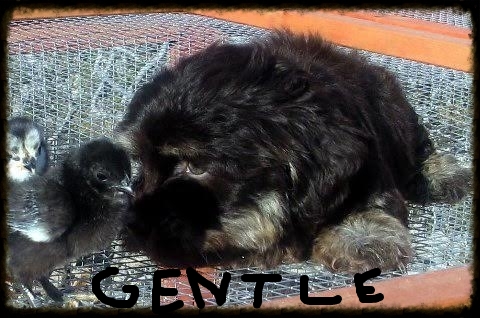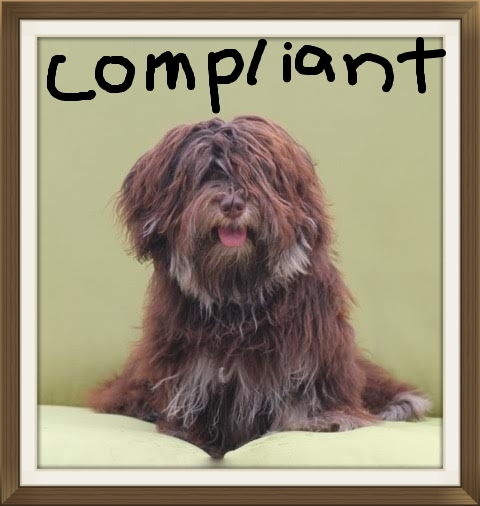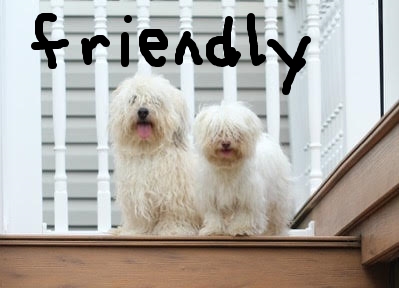For a breed, Havanese are relatively healthy dogs. You should be able to enjoy your Havanese for 15-18 years. A raw food diet is recommended, and the next best diet would be good quality kibble. Havanese are relatively calm dogs who.enjoy romping in the house and going for walks daily for their exercise. There are many different protocols for immunization, many articles written about the necessity and dangers of immunizations, and many different beliefs. Dayspring has puppies immunized at 9 weeks for Distemper, Hepatitis (CAV-2), Parainfluenza, Parvovirus. Repeat at 13 and 17 weeks. Rabies should be given as close to a year as possible. Titers are performed after that to test that the pup is still protected.
Havanese Standard
Official Standard of the Havanese (http://cdn.akc.org/Havanese.pdf)
General Appearance: The Havanese is a small, sturdy dog of immense charm. The native dog of Cuba, he is beloved as a friendly, intelligent and playful companion. He is slightly longer than tall, with a long, untrimmed, double coat. The Havanese has a short upper arm with moderate shoulder layback and a straight topline that rises slightly from the withers to the croup. The plumed tail is carried arched forward up over the back. The unique springy gait is a result of the breed's structure and playful, spirited personality. These characteristics of temperament, coat, structure and gait are essential to type.
Size, Proportion, and Substance: The ideal height is between 9 and 10½ inches, with an acceptable height range from 8½ to 11½ inches. Height at withers under 8½ inches or over 11½ inches is a disqualification, except that the minimum height shall not apply to dogs or bitches under twelve months of age. The height is slightly less than the length from the point of shoulder to point of buttocks, creating a rectangular outline. The Havanese is moderately boned and should never appear coarse or fragile.
Head: The expression is soft, intelligent and mischievous. Eyes are large, dark brown and almond-shaped. Chocolate dogs may have somewhat lighter brown eyes. Eye rims are solid black for all colors except for chocolate dogs which have solid brown eye rims. Incomplete or total lack of pigmentation of the eye rims is a disqualification. Ears are broad at the base, dropped, and have a distinct fold. They are set high on the skull, slightly above the endpoint of the zygomatic arch. When alert, the ears lift at the base but always remain folded. Ear leather, when extended, reaches halfway to the nose. The skull is broad and slightly rounded. The stop is moderate and the planes of the head are level. The cheeks are flat. Length of muzzle is slightly less than length of skull measured from stop to point of occiput. The muzzle is full and rectangular with a broad nose. The nose and lips are solid black for all colors except for chocolate dogs which have solid brown pigment. Incomplete or total lack of pigmentation of the nose or lips is a disqualification. Any color pigmentation other than black or brown on the eye rims, nose or lips is a disqualification. Small depigmented areas on lips due to rubbing against canine teeth will not disqualify. A scissors bite is ideal and a full complement of incisors is preferred.
Neck, Topline and Body: The neck is slightly arched, of moderate length, blends smoothly into the shoulders and is in balance with the height and length of the dog. The prosternum is evident but not prominent. The chest is deep, well developed, and reaches the elbow. The straight topline rises slightly from the withers to the croup. Measured from point of shoulder to point of buttocks, the body is slightly longer than the height at the withers. This length comes from the ribcage. Ribs are well sprung. The loin is short and well muscled. There is a moderate tuck-up. The tail is high-set and arches forward up over the back. It is plumed with long, silky hair. The tail plume may fall straight forward or to either side of the body. While standing, a dropped tail is permissible. The tail may not be docked.
Forequarters: The tops of the shoulder blades lie in at the withers, allowing the neck to blend smoothly into the back. Moderate shoulder layback is sufficient to carry the head and neck high. The upper arm is short. Elbows are tight to the body and forelegs are straight when viewed from any angle. The length from the foot to the elbow is equal to the length from elbow to withers. Pasterns are short, strong and flexible, very slightly sloping. Dewclaws may be removed. The feet have arched toes and point straight ahead. Pads and nails may be any color.
Hindquarters: The hind legs are muscular with moderate angulation. Hocks are well let down; pasterns are parallel from hock to foot. The croup is slightly higher than the withers. Dewclaws may be removed. The feet have arched toes and point straight ahead. Pads and nails may be any color.
Coat: Silky to the touch, the coat is soft and light in texture in both outer and undercoat, although the outer coat carries slightly more weight. The coat is long, abundant and wavy. It stands off the body slightly, but flows with movement. An ideal coat will permit the natural lines of the dog to be seen. Puppy coat may be shorter and have a softer texture than adult coat. A single, flat, frizzy or curly coat should be faulted. A coarse, wiry coat is a disqualification. A short, smooth coat with or without furnishings is a disqualification. The coat may be corded. Corded coats will naturally separate into wavy sections in young dogs and will in time develop into cords. Adult corded dogs will be completely covered with a full coat of tassel-like cords.
Color: All colors and marking patterns are permissible and are of equal merit. The skin may be any color.
Gait: The Havanese gait is springy. The characteristic spring is the result of the short upper arm combined with the rear drive. Front legs reach forward freely matching the moderate extension in the rear. On the move, the pads may be visible coming or going. The head is carried high and the slight rise in the topline holds under movement.
Temperament: The Havanese is friendly, playful, alert and intelligent with a sweet, nonquarrelsome disposition. Aggression or shyness should be faulted.
Presentation: Havanese should be shown as naturally as is consistent with good grooming. They may be shown either brushed or corded. The coat should be clean and well conditioned. In mature dogs, the length of the coat may cause it to fall to either side down the back but it should not be deliberately parted. Head furnishings are long and untrimmed, and may fall forward over the eyes or to both sides of the head; they may also be held in two small braids secured with plain elastic bands. The braids start above the inside corner of each eye and extend at least to the outside corner, forming the appearance of eyebrows. No other hair accessories are permitted. Minimal trimming of the anal and genital area is permissible but should not be noticeable on presentation. Hair on the feet and between the pads should be neatly trimmed. No other trimming or sculpting of the coat is permitted and is to be so severely penalized as to preclude placement. Havanese should be presented at a natural speed on a loose lead to properly assess the characteristic springy gait.
Faults: The foregoing description is that of the ideal Havanese. Any deviation from the above described dog must be penalized to the extent of the deviation. Disqualifications: Height at withers under 8½ or over 11½ inches except that the minimum height shall not apply to dogs or bitches under twelve months of age. Incomplete or total lack of pigmentation of the eye rims. Incomplete or total lack of pigmentation of the nose or lips. Any color pigmentation other than black or brown on the eye rims, nose or lips. A coarse, wiry coat. A short, smooth coat with or without furnishings. Approved August 9, 2011 Effective September 28, 2011














